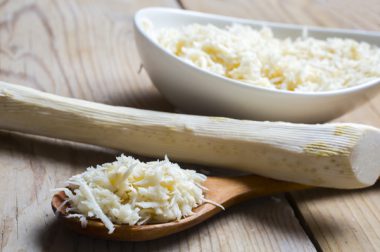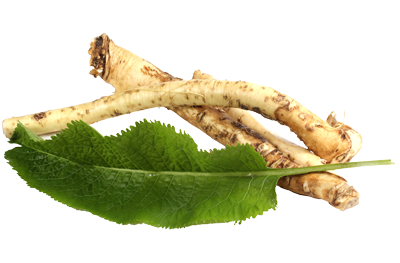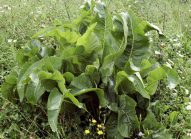Recipes we love
See all recipesHorseradish froth
A seasoning for vegetables that contains two to three times less fat than the usual butter, mayonnai...
Beetroot with horseradish
Vegetables really like spicy seasoning: it gives them just the right boost in flavour to win over ev...
Health
benefits
Packed with vitamin C!
Low in calories but denser than red radishes, horseradish is very high in vitamin C (for immunity, collagen formation, energy, the nervous system, and iron absorption, and for fighting fatigue) (link). It has twice as much as oranges and much more than kiwis!
Horseradish is also:
- a source of potassium (for the nervous system, muscular function, and blood pressure)
- a source of fiber (for bowel movement regulation, satiety)
They also contain:
- calcium
- magnesium
- antioxidants
- glucosinolates (cancer-fighting compounds)
Horseradish is not eaten in very large quantities, so its highly beneficial nutritional qualities complement the daily value in nutrients covered by main meals.
Nutritional
composition
When is the right
time to eat it?
Fall and winter.
Horseradish is in season from September to March.
Vegetable patch or
urban balcony?
Horseradish ((Armoracia rusticana, in the Brassicaceae family) is an herbaceous perennial that grows well in fresh, rich, stirred soil rich in humus, in full sun.
To learn everything you need to know about growing horseradish, read the page on growing advice.
Choosing and
storing horseradish
Choose your horseradish well:
- The root should be firm and dense, without spots or soft areas.
Properly store your horseradish:
- In the refrigerator: Store for several months in a perforated plastic bag if it is fresh.
- Horseradish can also be frozen, but it loses its spiciness.
Tips and
tricks
How to prepare horseradish
Horseradish is available fresh (though rarely); it is more often sold prepared, pickled in vinegar.
When fresh, it should be peeled (watch out—it will make you cry even more than onions!), and the hard, fibrous parts and green parts in the center should be removed. It should be grated at the last minute so it keeps its characteristic pungency, then sprinkled with lemon juice so it remains white in color.
Horseradish is rarely cooked, and should be added at the end of cooking if it is.
Horseradish goes well with…
Raw: Grated or in a paste, horseradish is used as a condiment. It has a very strong flavor, both spicy and peppery. It sets off dishes with a delicate flavor, like cold poultry, white or red meats served cold, or cold cuts. Horseradish pairs very well with beets, grated carrots, red cabbage, beef, smoked fish, goat cheese, and shellfish, and adds a subtle elegance to tomato juice.
It is frequently eaten in Germany and the French region of Alsace and is used in Eastern European countries to go with sauces. That’s why it is also often called “German mustard”.
In England, a sauce of horseradish, vinegar, and cream is served with roast beef.
Horseradish is widely eaten in the United States, as it is in the Jewish community, where it is eaten with gefilte fish and served during holiday meals such as the Passover seder, for example.
Japanese wasabi: Horseradish is an essential ingredient in Japanese cuisine, eaten in the form of wasabi, notably alongside raw fish. Be careful—wasabi burns, and unlike with mustard, you feel the spiciness first in your nose!
Can everyone
eat it?

Young children
Children do not appreciate the spicy, peppery flavor of horseradish before the age of two. They should try out small quantities, as with all other condiments.
And everyone else…
People who are very sensitive to spice may enjoy horseradish more when mixed with crème fraîche for a milder taste.
See plenty of other tips for encouraging children to eat vegetables
Where does it come from?
Origins and varieties
Origins: Native to Eastern Europe and Asia Minor, horseradish has been known to humans since 1500 B.C.E.
Varieties: Horseradish is a plant with large leaves and small white or yellow flowers. Horseradish plants are divided by splitting the root; it is also the root that we eat. Wasabi is a variety of horseradish.



 Chard
Chard  Tomato
Tomato  Vegetable garden: growing zucchini (courgette)
Vegetable garden: growing zucchini (courgette) 










